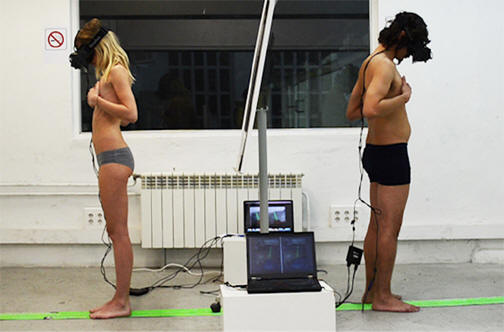Big Brother and Block Modeling
As
1984 approaches, a quiet revolution in computers and information
gathering may be bringing us closer than we realize to George Orwell’s
controlled state of Oceania. The public seems preoccupied with teen-age
computer “hackers” accessing sensitive computer systems. But our more
enduring fears should focus on a technology that corporations, nonprofit
organizations and governments are using with increasing frequency to
harness seemingly innocuous data from the personnel or communications
departments and adapt it in new and unexpected ways such as targeting
individuals for promotion or dismissal.
One name for this new computer game is block modeling – a programming technique that evaluates how employees fit within an organization on the basis of their relations with other employees. Recent impetus has come from such diverse independent quarters as Bell Laboratories, the American Broadcasting Companies, the Wharton School, and even the Institute for Social Management in Bulgaria.
Each of these organizations has recently spent time and money to develop advanced computer methods capable of “X-raying” a complex population- several hundred middle managers for example – to detect structural patterns of interaction and communication. And though these technologies certainly have significant benevolent uses, their premise is a recognizable extension of the “guilt by association” idea, and can therefore be abused.
Most crucially, these methods have the capacity to capitalize on the unguarded moments of ordinary people; to probe organizations for factional alignments in a low-visibility and therefore insidious way; to play to human biases – particularly among managers – to name names; and to give sometimes facile technological rationales for settling complex personnel problems.
Block-modeling does not require particularly sensitive information like tax returns medical histories. Rather, it exploits the unexpected, even uncanny synergy of large masses of “relational” data buried in organizational files. Examples of relevant data: Whom you talk with in your company; whose phone calls you do not return; whom you eat lunch with; whom you have worked with; who owes you favors; to whom to you send carbon copies of memos and letters; even whom you go bowling with. There is every expectation that far more such data bases will be routinely collected in the near future as minicomputer advances merger ever more widely with office information technology.
Only rarely will any relation between two people be very informative in isolation. But as many relations connecting many pairs of people accumulate, block modeling provides ways to distill frequently very striking and revealing patterns. Moreover, by throwing light on interlocking activities of specific people, block modeling goes a step beyond even the most refined kinds of geo-demographical data analysis such as extrapolating people’s characteristics by Postal Zip Code of residence.
The output of a block-model analysis is simple to state – even deceptively so since a large amount of advanced mathematics and computing is involved. The block model of the social structure chops the social group up into “blocs.” As Justice William O. Douglas once observed, a person is defined by the checks he writes. Blocs in similar positions in the relationship networks and who are thus likely to behave similarly in ways important to the organization, and be candidates for receiving similar “treatment.” Blocs can be, but don’t have to be, tightly-knit groups or factions. Two people may never have heard of each other, yet can end up in the same bloc because of common patterns of relationship with third parties.
In the mid-1970’s, we were part of a research team at Harvard that published the first papers on block-modeling’s social applications. The response was revealing. Places like mental institutions and rehabilitation centers in Lithuania were quick to request reprints. Perhaps they saw block-modeling as a way to ferret out dissidents. Later, members of the group received inquiries from the Swiss as well as West Germans whose questions (and travel reports sent back home) were especially exhaustive.
Interest then seemed to wane until two or three years ago, when a wave of, if often unobtrusive interest started coming from American business sources.
Possible uses of blockmodeling, beyond deciding promotions and dismissals, could include the following:
Identifying sources of grassroots opposition in hostile corporate takeover situations or bankruptcy reorganizations.
Indicating where to put the “good stuff” – raises, promotions, funding, new employees and perks.
Obtaining early warning of trouble spots portending possible “blowups”, in organizations, for example when internal tensions get out of hand, producing a wave of firings or resignations.
One name for this new computer game is block modeling – a programming technique that evaluates how employees fit within an organization on the basis of their relations with other employees. Recent impetus has come from such diverse independent quarters as Bell Laboratories, the American Broadcasting Companies, the Wharton School, and even the Institute for Social Management in Bulgaria.
Each of these organizations has recently spent time and money to develop advanced computer methods capable of “X-raying” a complex population- several hundred middle managers for example – to detect structural patterns of interaction and communication. And though these technologies certainly have significant benevolent uses, their premise is a recognizable extension of the “guilt by association” idea, and can therefore be abused.
Most crucially, these methods have the capacity to capitalize on the unguarded moments of ordinary people; to probe organizations for factional alignments in a low-visibility and therefore insidious way; to play to human biases – particularly among managers – to name names; and to give sometimes facile technological rationales for settling complex personnel problems.
Block-modeling does not require particularly sensitive information like tax returns medical histories. Rather, it exploits the unexpected, even uncanny synergy of large masses of “relational” data buried in organizational files. Examples of relevant data: Whom you talk with in your company; whose phone calls you do not return; whom you eat lunch with; whom you have worked with; who owes you favors; to whom to you send carbon copies of memos and letters; even whom you go bowling with. There is every expectation that far more such data bases will be routinely collected in the near future as minicomputer advances merger ever more widely with office information technology.
Only rarely will any relation between two people be very informative in isolation. But as many relations connecting many pairs of people accumulate, block modeling provides ways to distill frequently very striking and revealing patterns. Moreover, by throwing light on interlocking activities of specific people, block modeling goes a step beyond even the most refined kinds of geo-demographical data analysis such as extrapolating people’s characteristics by Postal Zip Code of residence.
The output of a block-model analysis is simple to state – even deceptively so since a large amount of advanced mathematics and computing is involved. The block model of the social structure chops the social group up into “blocs.” As Justice William O. Douglas once observed, a person is defined by the checks he writes. Blocs in similar positions in the relationship networks and who are thus likely to behave similarly in ways important to the organization, and be candidates for receiving similar “treatment.” Blocs can be, but don’t have to be, tightly-knit groups or factions. Two people may never have heard of each other, yet can end up in the same bloc because of common patterns of relationship with third parties.
In the mid-1970’s, we were part of a research team at Harvard that published the first papers on block-modeling’s social applications. The response was revealing. Places like mental institutions and rehabilitation centers in Lithuania were quick to request reprints. Perhaps they saw block-modeling as a way to ferret out dissidents. Later, members of the group received inquiries from the Swiss as well as West Germans whose questions (and travel reports sent back home) were especially exhaustive.
Interest then seemed to wane until two or three years ago, when a wave of, if often unobtrusive interest started coming from American business sources.
Possible uses of blockmodeling, beyond deciding promotions and dismissals, could include the following:
Identifying sources of grassroots opposition in hostile corporate takeover situations or bankruptcy reorganizations.
Indicating where to put the “good stuff” – raises, promotions, funding, new employees and perks.
Obtaining early warning of trouble spots portending possible “blowups”, in organizations, for example when internal tensions get out of hand, producing a wave of firings or resignations.
In fact, one of the earliest application of this class of methods was set in a Roman Catholic monastery which in the late 1960’s was on the brink of organizational collapse. The block model successfully identified three factions – loyalists, “Young Turks,” and outcasts – whose membership foreshadowed the way the organization would unravel. In an application to a more complex organization in difficulties, the block model not only correctly identified the outcast group, whose members would be dismissed, but also detected a submerged case of personnel misassignment in a different corner of the organization.
With proper safeguards, use of such methods can be sound, ethical and constructive. Obviously, internal sudit departments should at times be permitted to scrutinize employees closely. But stride sin the new “guilt-by-association” technologies are easily outstripping the vastly slower evolution of protective legal and administrative responses.
The typical employee whose position is likely to be most vulnerable to a block-model analysis is the middle manager, who has a family, a mortgage and a career locked into the XYZ Corporation. If the model locates him in a favorably regarded bloc, innocence by association prevails and all is well. But if he associated with known non-cooperators, or worse still, is assigned to a bloc judged likely to split off and found a rival company, he then can be passed over in the next promotion.
Inevitably, these new technologies create an unusually sensitive and complex web of management, privacy, information access, social control, and legal liability problems. In the end, the true 1984 threat lies not so much in the computer methods themselves, but in our society’s slowness to react. http://bahoowah.blogspot.com/2008/10/big-brother-and-block-modeling.html









